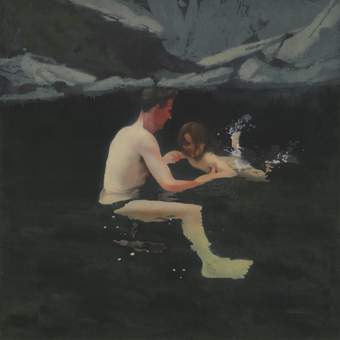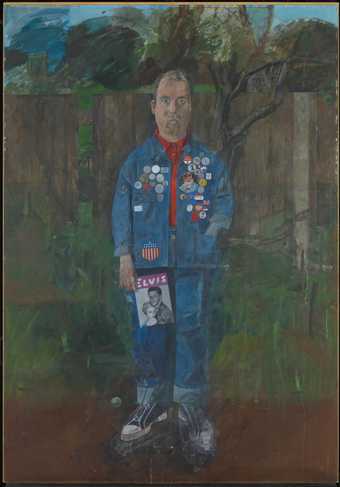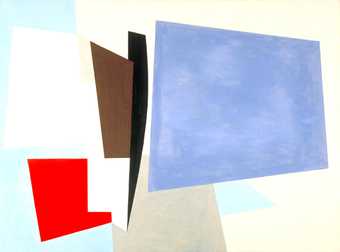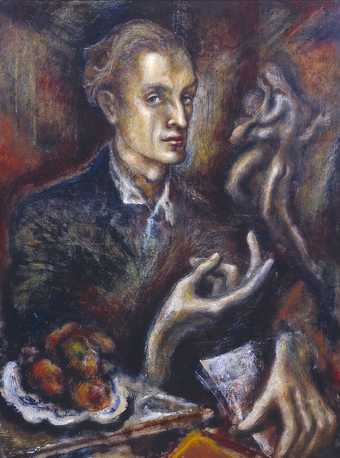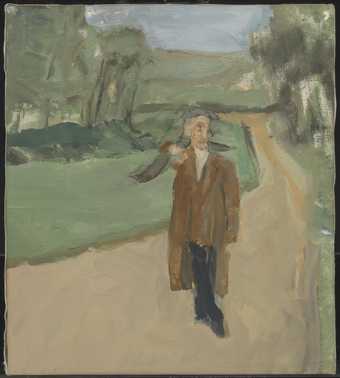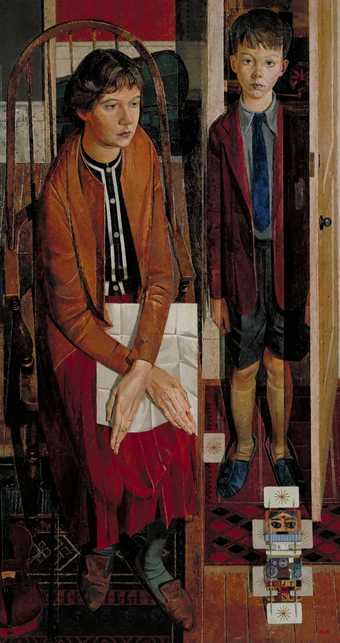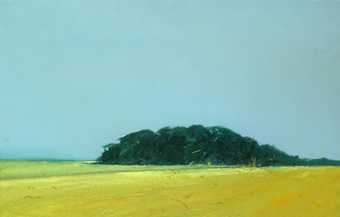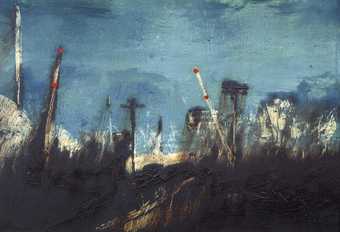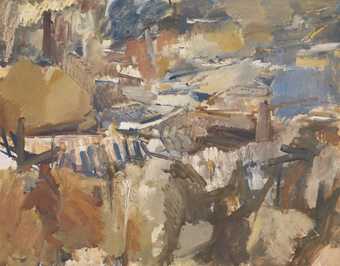
Not on display
- Artist
- Michael Andrews 1928–1995
- Medium
- Oil paint on board
- Dimensions
- Frame: 797 × 698 × 46 mm
- Collection
- Tate
- Acquisition
- Accepted by HM Government in Lieu of Inheritance Tax from the collection of Lord & Lady Attenborough and allocated to Tate 2018
- Reference
- T15554
Summary
In Self-Portrait 1958–9 Michael Andrews represents his head and torso in a frontal pose, his gaze raised and projected ahead. He is wearing ordinary, informal clothes: a shirt with the collar unbuttoned, a red jumper and a dark jacket. It is one of very few known self-portraits by Andrews. In this work the painter confronts his own image without self-regard or sentimentality; his image lacks the theatricality of Francis Bacon’s (1909–1992) self-portraits or the intensely self-assured stance of many of those by Lucian Freud (1922–2011), both of whom were Andrews’s friends and contemporaries in post-war London. Self-Portrait shows a painter who is not aiming to create an iconic image of himself, but who is appraising himself, searching and seeking knowledge through visual scrutiny. In this respect, the painting can be seen in relation to the teaching of William Coldstream, Professor at the Slade School of Fine Art in London at the time Andrews was a student there, as well as the work of Freud, who also taught Andrews at the Slade and became his close friend.
In contrast to Andrews’s large compositions of figures from this period, such as The Deer Park 1962 (Tate T01897), which relied heavily on photographic sources taken from magazines as well as art historical reproductions, his portraiture is seemingly more naturalistic and was executed from both observation and imagination. Of portraiture, Andrews said: ‘All true appreciations of people are bound to be blurred (I think this goes for images too). Finding a bit here, a bit there – its [sic] all approximate. Everything is “more or less” in my opinion.’ (Quoted in Tate Britain 2001, p.14.) The genre occupied Andrews in the late 1950s and early 1960s particularly, though he pursued it to a lesser extent throughout his career. His ambition to convey a sense of the approximation of the experience of life was channelled in his use of disparate sources, painting the same image from memory and from life as well as using photographic references. As in other paintings from this period, such as Portrait of Tim Behrens 1962 (Museo Nacional Thyssen-Bornemisza, Madrid), the face in Self-Portrait is the part of the image described with more clarity and precision.
Andrews painted the picture on board rather than on canvas, possibly because this support allowed him to manipulate the paint more easily. Built up in layers of paint over an initial darker tone, the background of the picture and the jacket register the painter’s vigorous brushstrokes. The paint is applied with different and often contrasting directionality and tonalities, which confer to these elements an abstract and gestural quality. By contrast, the face is painted in a more detailed and naturalistic manner, reflecting the fact that when we look at a person in real life, the face is what we mostly focus on, while other details, such as clothes and background, are of lesser importance and are often registered less clearly.
Further reading
Paul Moorhouse, The Transformation of Appearance: Andrews, Auerbach, Bacon, Freud, Kossoff, exhibition catalogue, Tate Gallery, London 1991.
Colin St John Wilson, The Artist at Work: On the Working Methods of William Coldstream and Michael Andrews, London 1999.
Paul Moorhouse, ‘“Strange Consolation”: The Art of Michael Andrews’, in Michael Andrews, exhibition catalogue, Tate Britain, London 2001.
Elena Crippa
January 2018
Does this text contain inaccurate information or language that you feel we should improve or change? We would like to hear from you.
You might like
-
Michael Andrews A Man who Suddenly Fell Over
1952 -
Jean Cooke (Jean Bratby) Self-Portrait
1958 -
Michael Andrews The Deer Park
1962 -
John Wells Painting
1957 -
Michael Andrews Melanie and Me Swimming
1978–9 -
Peter Blake Self-Portrait with Badges
1961 -
Patrick Caulfield Greece Expiring on the Ruins of Missolonghi (after Delacroix)
1963 -
John Wells Painting
1956 -
Leslie Hurry Self-Portrait
1944 -
Michael Andrews Study for a Man in a Landscape (Digswell)
1959 -
Norman Blamey My Wife and Son
1959 -
Colin Self Large Harvest Field and Woods near Happisburgh, Norfolk
1984 -
Colin Self The Crossing
1985 -
Leon Kossoff Self-Portrait
c.1952 -
Dennis Creffield Isle of Dogs from Greenwich Observatory
1959





